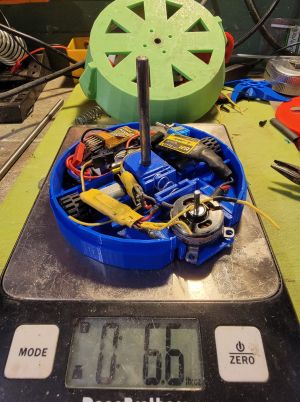Plastic Antweights
Western Allied Robotics introduced Plastic Antweights (also called "Plastic Ants" or just "Plants") in 2015. Since then they have rapidly gained popularity, and SPARC has adopted rules for their use.
The spirit of the Plastic Ant class is to have an easy entry point for new builders, and to encourage creative designs by limiting materials to easy-to-use plastics that are commonly used in 3D printers, which don’t have strength characteristics common in the standard classes. These limitations not only make the class easy to build for, but have encouraged a lot of creative designs not otherwise seen in the full-combat 1lb antweight class.
Important Notes
Many if not most events will require plastic parts to be only 3D printed. This is primarily to prevent people fielding robots with solid milled plastic parts that are much stronger than a printed version of the same. However, other types of parts may be affected; for example, ABS sheet material might be disallowed as well. If in doubt, always check local rules or discuss with your event organizer.
Plenty of non-plastic materials can be used in portions of the Plastic Ant robot class. Foam and other soft materials are allowed for internal shock absorption, as well as on wheels/tires for suitable traction. Metal fasteners can be used as long as they don't act as armor or weapon impactors. Where screws appear on the surface they should be countersunk or shrouded to meet this requirement.
Allowed Plastics
PLA
PLA is inexpensive, but brittle.[1] It is the most common 3D printing filament. It rarely warps in use and is great for tiny parts.[2] It's a great starter material, and recommended for printing prototype parts. Many builders prefer other plastics, especially for their active weapons or armor. Pure PLA is made from cornstarch[3] and gives off a corn syrup odor which reminds some people of waffles.
PLA+
Various manufacturers offer "PLA+" and/or "Tough PLA," which are modified PLA filaments that are meant to be less brittle. With an acrylic additive, for instance, it may show much better impact resistance.[4] Inland and eSun claim their PLA+ products are 10x stronger than regular PLA.
PET
PET (Polyethylene terephthalate) is somewhat brittle so it isn't the best choice for robot parts that are likely to receive damage but it is very rigid and can be useful for parts where rigidity is key.
PETG
PETG (a copolyester) is more heat resistant, more flexible, and less brittle than PLA.[5] It is well suited for 3D printing mechanical parts. Since it is more likely to flex under impact its resilience may be useful to the bot builder, but it is 2-3% heavier than PLA. Observe manufacturer's recommendations when printing, as it tends to stick very strongly to smooth print beds. You'll notice a fairly mild hot-plastic odor when printing.
ABS
ABS is a strong and reasonably impact-resistant material at a moderate price, but warps easily and smells worse while printing. Its low density makes it one of the lightest of all printable plastics (PLA is about 20% heavier for the exact same print). You'll probably need to print it in an enclosure for best results; this keeps its temperature even during printing, so that it only shrinks after printing instead of curling or warping during printing. Many hobbyists ventilate the enclosure to the outdoors with fan(s) due to the odor.
OTHER
Individual events can allow other plastics that meet the intent of the rules. If you are really itching to use another kind of plastic like HIPS, contact your event organizer and see what they say. If you want to use a durable or high performance plastic like nylon, you should just build for the open-ant class.
